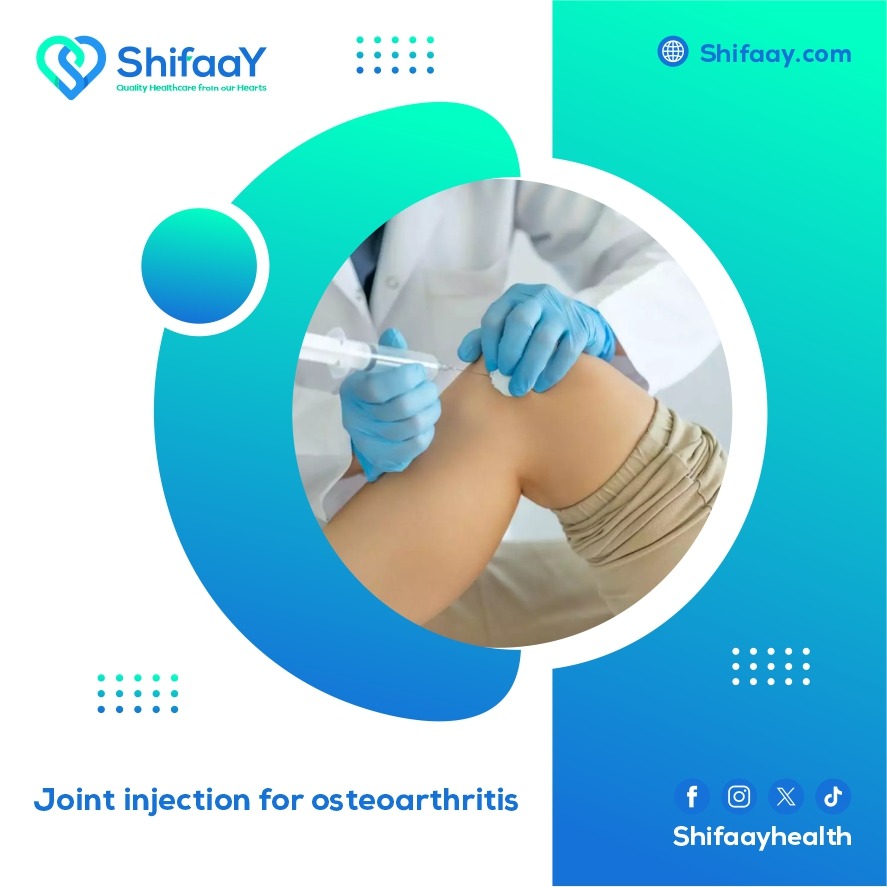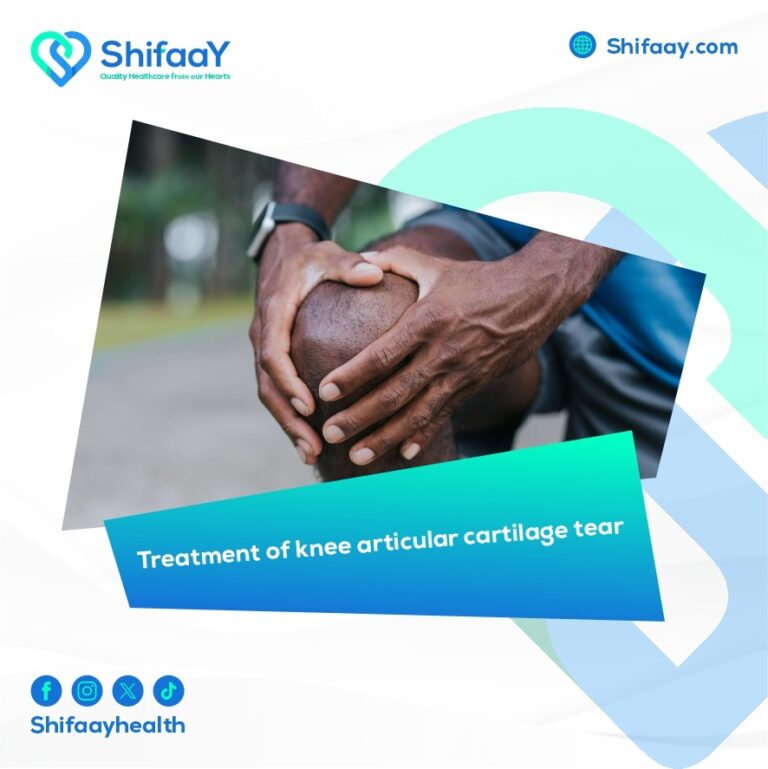Joint injection for osteoarthritis, the best types, their benefits and side effects
Joint injection for osteoarthritis is a commonly asked question by people who constantly experience severe inflammation and excruciating joint pain. It is one of the most significant and recent modern techniques for treating all types of arthritis and lessening associated pain. Thus, if you have chronic arthritis, you have probably had long-term issues and side effects from arthritis medications because these medications have an adverse effect on the digestive system and stomach when used for an extended period of time.
Joint injection for osteoarthritis may therefore be the best option and the ideal solution for all medical cases that suffer from this chronic inflammation, as they always eliminate the need to take any medications or drugs that are bothersome and damaging to the stomach and digestive system. Within the paragraphs of our article, we will provide you with all the pertinent facts and information regarding joint injection for osteoarthritis, including the most effective techniques and treatment approaches. Additionally, we discuss the main categories of materials utilized in this therapeutic approach, as well as their advantages and disadvantages.
Joint injection for rheumatoid arthritis

Rheumatoid arthritis is a common disease that affects many people around the world. Its symptoms include pain, swelling, and stiffness in the joints. These symptoms limit mobility and have a negative impact on one’s quality of life, but joint injections for osteoarthritis are one of the most effective ways to alleviate all of these symptoms.
Note that all chronic diseases, including rheumatoid arthritis and degenerative arthritis, may be treated with joint injection for osteoarthritis by the doctors and consultants at Shifaay Center,the best medical tourism center in Egypt, which specialize in bone and joint medicine. These injections are important because they always help to reduce inflammation and restore function to injured joints. They also play a critical role in strengthening articular cartilage and reducing associated pain.
Follow also: Cost of scaphoid bone fracture surgery in the wrist
The best Joint injection for osteoarthritis
Some people with arthritis may experience worsening pain every day because analgesics frequently lose their ability to reduce pain over time. Additionally, when inflammation develops, the usual medications may no longer be able to repair damaged cells or even keep the affected joints in good condition while preventing further damage. With the development or proliferation of contemporary medicine, as well as the variety of therapeutic approaches available for restoring the health of the afflicted joints and regenerating cartilage, doctors and consultants with expertise in bone and joint medicine may be able to treat a wide range of medical conditions involving severe pain from chronic arthritis.
Therefore, if you are among those who always experience the excruciating pain of severe arthritis, you can get the right medication by speaking with the orthopedic specialist on staff at Shifaay Center. Together, you can decide which type of joint injection for osteoarthritis is best for you and your condition. There are many different kinds of these injections, but the most effective and significant ones are as follows:
● Plasma injection.
● Ozone injection.
● Hyaluronic acid injections.
● Botox injections.
● Mesotherapy injection.
Types of joint injection for osteoarthritis according to the substance used
Osteoarthritis can be effectively treated with a variety of joint injection techniques that also effectively reduce inflammation, swelling, and pain while partially repairing the damaged joint tissues. Depending on the material used, there are several different types of joint injections for osteoarthritis, but the following are the most important and fay types.
● Cortisone injections.
● Hyaluronic acid injection.
● Stem cell injection.
● Platelet-rich plasma injection.
● Steroid injections.
● Central bone marrow injection.
● Omega-3 injections.
The following lines and paragraphs in this article will provide a brief outline of the most important of these types:
● Joint injections with cortisone
Orthopedists typically recommend cortisone joint injections for patients who regularly experience severe pain and joint swelling and who want to feel better and recover quickly. Cortisone can be mixed with strong anesthetics and injected into the injured joint; this will provide complete relief from pain, acute swelling, and inflammation for up to one month. The necessity for cortisone injections into the affected joint varies from patient to patient and is based on how much the procedure improves quality of life. It is noteworthy that cortisone injections can be used in a variety of joints, including the hands, feet, elbow, knee, hip, and spine.
● Hyaluronic acid injection for the knee
Hyaluronic acid is one of the most important naturally occurring substances found in joints because of its viscous properties, which act as a lubricant to lessen bone-to-bone friction. Hyaluronic acid injections into the knee have been the subject of several studies that have shown and confirmed to replenish the gelatinous material lost as a result of joint swelling and inflammation, as well as to lessen pain associated with stiff joints.
Note that hyaluronic acid injections are used to treat knee pain in patients with intermediate-stage arthritis who may not have severe pain. Depending on the patient’s condition and how well he responds to this treatment, one injection is given once a week for a period of three to five weeks. It is important to remember that these injections can always provide total relief from arthritis symptoms for a maximum of six months.
● Injection of stem cells into joints
The concept of injecting stem cells into inflamed joints may rely on the many anti-inflammatory compounds released from these cells in the joints, since these compounds always aid in the regeneration of joint cells. Stem cells used to treat arthritis are taken from the bone marrow or fat cells of the afflicted disease. Although this helpful technique is still undergoing testing, numerous studies have been conducted that attest to its efficiency, effectiveness, and noticeable improvement in symptoms.
● Platelet-rich plasma injection
According to recent studies, plasma obtained from blood that has been separated in a laboratory may contain a sizable amount of essential proteins and platelets, which have a range of anti-inflammatory and analgesic properties in addition to immune-stimulating properties. This is why platelet-rich plasma has recently been used in the treatment of arthritis. This is accomplished by extracting it from an arthritic patient’s blood and injecting it into the affected joint once a week, for a maximum of three weeks in a row, contingent upon the patient’s condition.
Mechanism of action of joint injection for osteoarthritis in light of the high prevalence of chronic arthritis
Since a large number of people worldwide suffer from chronic arthritis, effective therapeutic methods and techniques have been developed and are being used to treat this inflammation without entail any of the dangers or complications that come with surgery. Among these techniques, local injections are the most widely used. The basic concept involves injecting therapeutic and anti-inflammatory substances directly into the inflammatory portion of the joint with the aim of treating all inflammation, relieving pain, and rebuilding damaged joint tissue.
Joint injection damage
Many patients with arthritis may encounter some unusual side effects and harms, even though the joint injection for osteoarthritis technique is believed to be one of the safest and most effective when used under the supervision of a top orthopedist with years of experience and extensive training in this field:
● Slight flare-up.
● infection of the serum, which could happen if the injections are given in an unsterile environment.
● Redness and swelling of the joint after the injection.
Severe joint pain following injections.
● Allergy to the materials used to sterilize the joint area.
● Allergy to materials used in joint injections.
The injection-related pain usually goes away after two days, but the orthopedic doctor at Shifaay Center may prescribe anti-edema and pain-relieving medications to help reduce all of these negative effects and side effects.
joint injection for osteoarthritis price

Everyone is undoubtedly aware that the cost of a joint injection for osteoarthritis can vary depending on a number of crucial elements and factors, including the type of injection, the substance used in the injection, the number of sessions needed, the location, the degree of experience and reputation of the treating doctor, the proven efficacy and quality of the injections, costs, the materials required for the injections, additional treatment costs related to them, and other such elements. Therefore, it could be very difficult to determine the precise cost of joint injection for osteoarthritis; however, in general, joint injection for osteoarthritis may be found to be in the range of reasonable to expensive.
Because of this, it is best to consult with an orthopedic or joint doctor at Shifaay Center, which is thought to be the best medical tourism Center in Egypt, about all the details and information pertaining to the cost of a joint injection for osteoarthritis.
Follow also: Treatment of knee articular cartilage tear
Important instructions after receiving joint injection for osteoarthritis
There is a set of important necessary instructions and directions that may always be requested from patients after receiving joint injection for osteoarthritis, the most prominent of which are the following:
● Apply ice to the injection site as needed to alleviate pain.
● Avoid using hot water pads.
● Do not use hot water, a bathtub, or a whirlpool bath for two days in a row, but a shower may be permitted.
● The injection site must be covered for one to two days.
● Infection signs should be monitored.
● Monitor for increased pain, redness, and swelling, which may last more than 48 hours.
What are the best joint injection for osteoarthritis?
Although there are many joint injection options available for treating osteoarthritis, injections of mesotherapy, Botox, hyaluronic acid, plasma, and ozone continue to be the most effective.
How is the joint injected?
Before injecting a joint, there are a few important steps that need to be taken. These include cleaning the area surrounding the injection site, dressing in medical clothes and donning medical gloves, positioning oneself so that the needle can be inserted easily into the joint, and finally spraying the joint with anesthetic after the needle is inserted. Typically, the specialized doctor will use ultrasonography or a form of X-ray to see the needle’s actual path inside the body so that it is inserted in the right spot.
What is the benefit of joint injection for osteoarthritis?
Joint injection for osteoarthritis provides many benefits, such as reduced edema, pain and inflammation, and joint reconstruction of all damaged and diseased tissue.
How can side effects resulting from joint injection for osteoarthritis with cortisone be reduced?
The side effects resulting from cortisone joint injection for osteoarthritis can be reduced by reducing the calories consumed during the day, maintaining exercise, following a low-cholesterol diet, following a low-sodium diet, and reducing the dose if the person suffers from severe mood swings, take the dose after eating a meal or with antacid medications to relieve stomach irritation and continuously check your blood pressure and sugar level.
When is the schedule for repeated joint cortisone injections determined?
There are many concerns that always limit the frequency of cortisone joint injection for osteoarthritis, given that it can harm the cartilage inside the joint. Therefore, doctors usually reduce the frequency of cortisone injections into the joints, and this depends on the number of injection times, diagnosis, and other factors.
What preparations are necessary before performing joint injection for osteoarthritis?
There are a few things you should do before starting the cortisone joint injection for osteoarthritis. For example, you should wait a few days before taking any blood-thinning medications, refrain from taking any nutritional supplements, and let your specialist doctor know if you have hypertension or if the temperature rises to 38 degrees Celsius.






